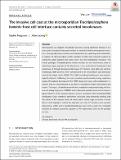Files in this item
The invasive cell coat at the microsporidian Trachipleistophora hominis-host cell interface contains secreted hexokinases
Item metadata
| dc.contributor.author | Ferguson, Sophie | |
| dc.contributor.author | Lucocq, John | |
| dc.date.accessioned | 2018-07-27T08:30:09Z | |
| dc.date.available | 2018-07-27T08:30:09Z | |
| dc.date.issued | 2019-04 | |
| dc.identifier | 254954501 | |
| dc.identifier | 3f8da37a-aac3-4c81-b961-e7d4aa62eb58 | |
| dc.identifier | 85051208399 | |
| dc.identifier | 000466794200023 | |
| dc.identifier.citation | Ferguson , S & Lucocq , J 2019 , ' The invasive cell coat at the microsporidian Trachipleistophora hominis -host cell interface contains secreted hexokinases ' , Microbiology Open , vol. 8 , no. 4 , e00696 . https://doi.org/10.1002/mbo3.696 | en |
| dc.identifier.issn | 2045-8827 | |
| dc.identifier.other | ORCID: /0000-0002-5191-0093/work/64361196 | |
| dc.identifier.uri | https://hdl.handle.net/10023/15715 | |
| dc.description | Funding: Wellcome Trust (Grant Number: 089803/D/09/Z), 600th anniversary studentship from the University of St Andrews. | en |
| dc.description.abstract | Microsporidia are obligate intracellular parasites causing significant disease in humans and economically important animals. In parallel to their extreme genetic reduction, Microsporidia have evolved novel mechanisms for exploiting host metabolism. A number of microsporidians confer secretion of otherwise cytosolic proteins by coding for signal peptides that direct entry into the endoplasmic reticulum. The human pathogen Trachipleistophora hominis encodes for four hexokinases, three of which have signal peptides at the N‐terminus. Here, we localized hexokinase 2 and hexokinase 3 through developmental stages of T. hominis using light and electron microscopy. Both proteins were concentrated in an extracellular coat previously termed the plaque matrix (PQM). The PQM (containing hexokinases) was morphologically dynamic, infiltrating the host cytoplasm predominantly during replicative stages. Throughout development the PQM interacted closely with endoplasmic reticulum that was demonstrated to be active in membrane protein biosynthesis and export. The impact of hexokinase on the host metabolism was probed using the fluorescent analog of glucose, 2‐NBDG, which displayed spatially restricted increases in signal intensity at the parasite/vacuole surface, coincident with hexokinase/PQM distribution. Gross metabolic aberrations, measured using metabolic profiling with the Seahorse XF Analyzer, were not detectable in mixed stage cocultures. Overall, these results highlight a role for the extended cell coat of T. hominis in host–parasite interactions, within which secreted hexokinases may work as part of a metabolic machine to increase glycolytic capacity or ATP generation close to the parasite surface. | |
| dc.format.extent | 19 | |
| dc.format.extent | 3003163 | |
| dc.language.iso | eng | |
| dc.relation.ispartof | Microbiology Open | en |
| dc.subject | Cell coat | en |
| dc.subject | Hexokinase | en |
| dc.subject | Immuno-EM | en |
| dc.subject | Microsporidia | en |
| dc.subject | QR Microbiology | en |
| dc.subject | NDAS | en |
| dc.subject | SDG 3 - Good Health and Well-being | en |
| dc.subject.lcc | QR | en |
| dc.title | The invasive cell coat at the microsporidian Trachipleistophora hominis-host cell interface contains secreted hexokinases | en |
| dc.type | Journal article | en |
| dc.contributor.sponsor | The Wellcome Trust | en |
| dc.contributor.institution | University of St Andrews. School of Medicine | en |
| dc.contributor.institution | University of St Andrews. Cellular Medicine Division | en |
| dc.contributor.institution | University of St Andrews. Biomedical Sciences Research Complex | en |
| dc.identifier.doi | 10.1002/mbo3.696 | |
| dc.description.status | Peer reviewed | en |
| dc.identifier.grantnumber | 089803/B/09/Z | en |
This item appears in the following Collection(s)
Items in the St Andrews Research Repository are protected by copyright, with all rights reserved, unless otherwise indicated.

